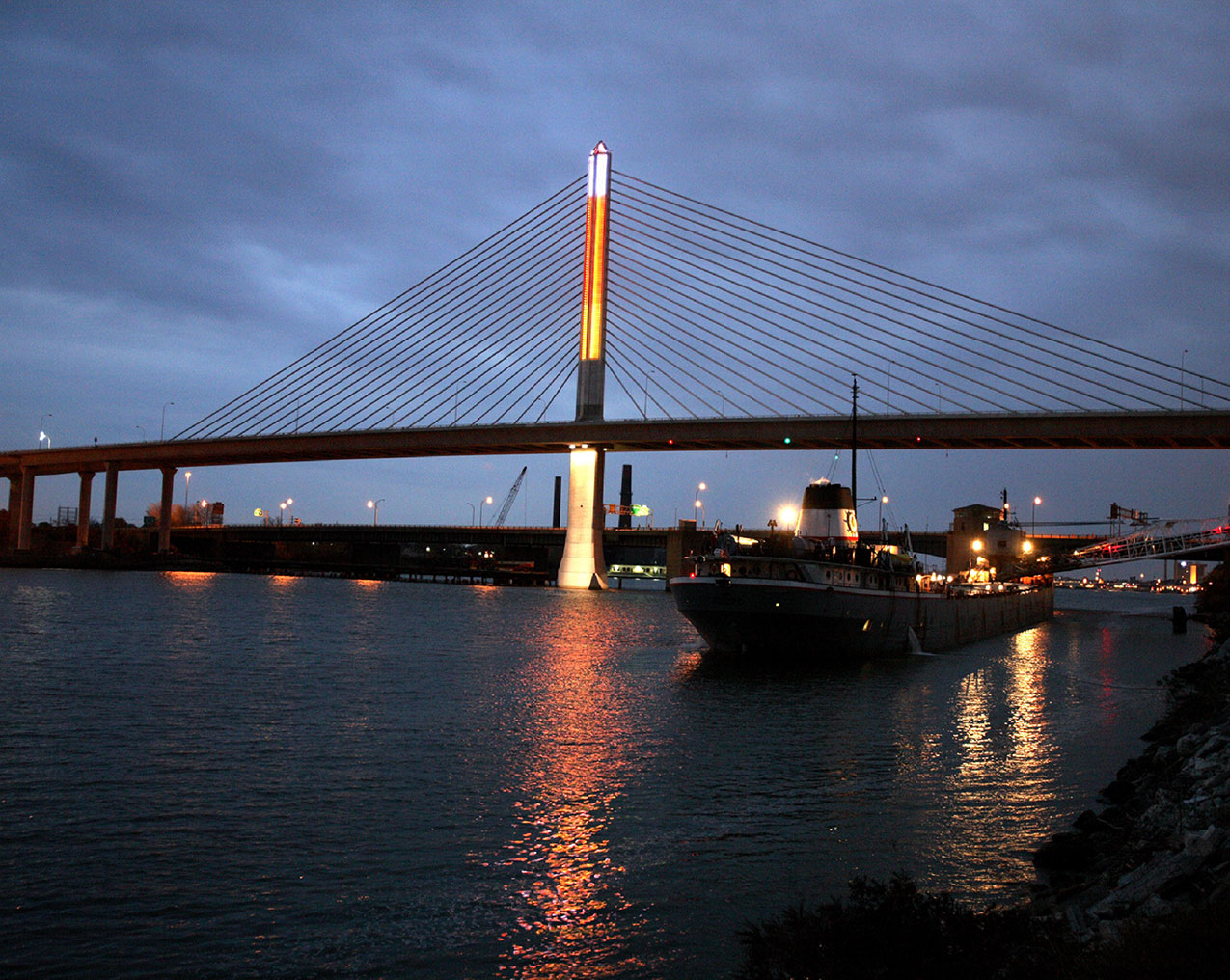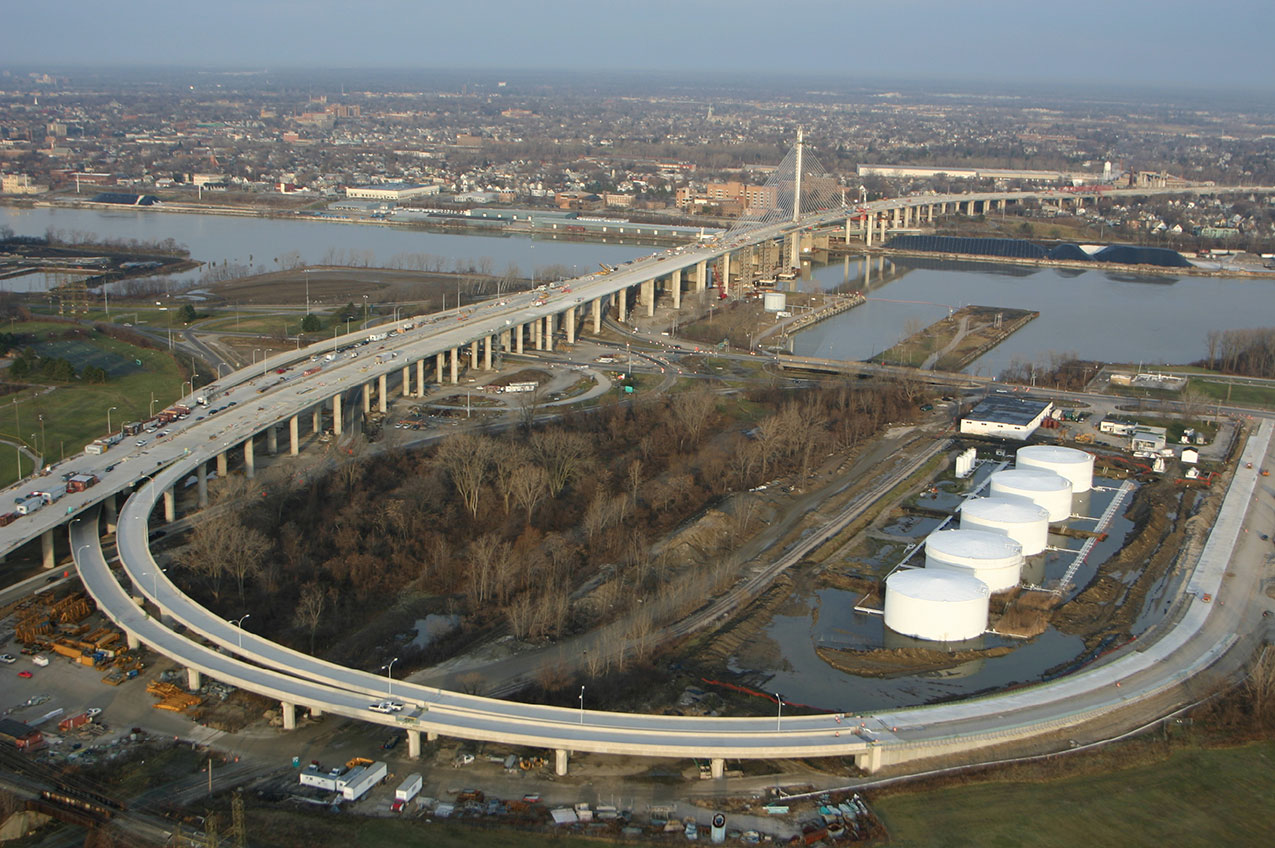I-280 Veterans’ Glass City Skyway – Toledo, Ohio
Toledo’s new bridge landmark, the I-280 Veterans’ Glass City Skyway, replaces one of the last bascule spans on the Interstate system and provides for uninterrupted traffic flow along I-280 in the heart of Toledo, while freight is moved easily in and out of the Port of Toledo on the Maumee River. The 8,800’ long new bridge includes a 1,525’ cable-stayed main span unit with aesthetics centered around a theme of glass to honor the city’s industrial heritage. This segmental concrete bridge features many firsts and new innovations in the segmental bridge industry.
Innovation of Design and/or Construction
The bridge features a 440’ tall single pylon, with the upper 196’ faced in glass on all four sides. This achieved a community goal of incorporating glass in a highly visual way in the new bridge. Industries in the City of Toledo are recognized as world leaders in the manufacturing and development of specialty glass, thus the community wished to showcase this material. Behind the glass are 384 LED fixtures programmed to provide shows throughout the year. Each fixture is capable of 16.7 million colors, translating to an infinite array. The I-280 Veterans’ Glass City Skyway is the first cable stayed bridge in the world to utilize glass as a major element in the pylon and one of the first uses of LED fixtures for aesthetic lighting of a major bridge.
The I-280 Veterans’ Glass City Skyway is one of two cable-stayed bridges in the world to utilize a cradle system to carry the stays through the pylon. This system was recognized with the 2007 Charles Pankow Award for innovation. The cable stay strands are primary tensile strength elements that run from an anchorage at the bridge deck, through the stay cradle in the pylon and back to the bridge deck, transferring naturally compressive forces to the pylon through the curved portion of the cradle. Epoxy coated steel stay cable strands are housed in individual steel tubes in the curved portion of the cradle. During fabrication, grout is injected into the spaces between the tubes, allowing the individual epoxy-coated strands to remain ungrouted and act independently, simplifying maintenance and inspection and improving long term durability. Each stay incorporates two reference strands that may be removed, inspected and replaced with the same, or potentially newer materials, at any point in the future. Since each strand is independent from the others, this allows for an increase in the number of strands in a stay. Four stays use 156 strands, becoming the largest cable stays in the world.
The stay sheathing and cradles are stainless steel, another first use in the world. The reflectivity of stainless steel achieved aesthetic goals, along with providing the most economical life cycle costs. The cable-stayed main spans utilize precast delta frames to transfer forces from adjacent box girders to the cable stays. This patented innovation has been used on just three other American cable-stayed bridges and results in a single plane of stays.
Aesthetics and/or Harmony with the Environment
The bridge aesthetics were developed around the community-selected theme of glass, with the majority of the elements selected during design workshops or charettes with the community. During these public workshops, aesthetic options were presented, discussed and then voted on, building consensus along the way.
Perhaps the most unique element of the new bridge is the pylon at night. The glass panels are backlit by 384 LED fixtures, each capable of producing 16.7 million colors, resulting in a nearly infinite number of displays. Numerous ‘shows’ have been pre-programmed to run through the year during specific holidays, seasons and sporting events.
The single pylon provides Toledo with the greatest opportunity for a bridge landmark reflective of their history in the glass industry. The location of the shipping channel on the north side of the river accommodates the pylon near the middle of the river, without impacting river traffic.
The community voted for a single plane of stays, supporting the desire for visual impact, elegant appearance and undisturbed views for drivers, along with a clear separation of northbound and southbound traffic. Voting resulted in a fan arrangement for the stays drawing viewers’ eyes up in concert with the project slogan – “Look up Toledo!”
Cost Competitiveness
2.75 miles of ramps, roadway and cable-stayed main span (1.2 million square feet of bridge deck) were completed for $237 million, while providing hundreds of local jobs during construction. Economy was achieved through repetition in the design of the structural system. Use of the cradle system generated approximately $3 million in material savings. High-performance concrete was utilized throughout the structure, resulting in a durable, low-maintenance bridge with a service life of at least 100 years. A life cycle cost/benefit analysis was completed to evaluate the use of stainless steel cable stay sheathing and given the minimal maintenance that will be necessary, this choice was found to be financially attractive.
Jury Comments
The cradle system developed for the project is an advancement and innovation in cable stayed design. The use of stainless-steel sheathing, epoxy coated strand, and reference cables to monitor performance provides the owner a durable and maintainable bridge for future generations. The pylon accented with glass backlit panels is an artistic way to recognize the history of Toledo’s glass industry. Community involvement was key to the success of this outstanding project.
2009 ASBI Bridge Award of Excellence
State:
Ohio
Designer:
FIGG
Owner:
Ohio Department of Transportation
Contractor:
Fru-Con Construction, a member of Bilfinger Berger AG
Construction Engineer:
International Bridge Technologies, Inc.
Construction Engineering Inspection:
FIGG
Formwork for Precast Segments:
EFCO
Erection Equipment:
Strukturas, Paolo di Nicola
Post-Tensioning Materials:
Dywidag Systems International, USA, Inc. (DSI)
Stay Cables:
Dywidag Systems International, USA, Inc. (DSI)
Bearings:
The D.S. Brown Company
Expansion Joints:
The D.S. Brown Company
Epoxy Supplier:
Sika Corporation
Prepackaged Grout:
BASF Building Systems, DSI






